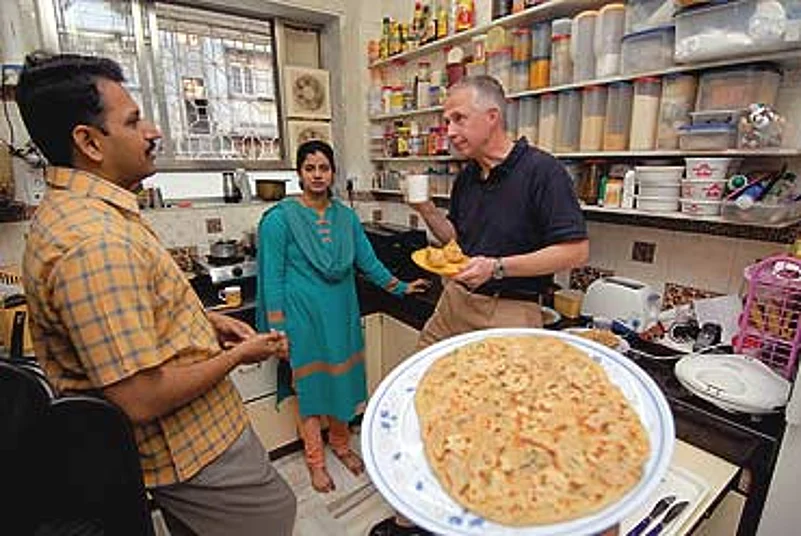- The Bed & Breakfast scheme aims to fill the 1,50,000 hotel rooms shortfall in India. The first goal: 30,000 B&B rooms in Delhi before the Commonwealth Games.
- B&BS will be of two classes-Silver and Gold, priced at Rs 1,000-1,500 and Rs 2,000-plus per night. A one-time application fee of Rs 5,000.
- Each room must be air-conditioned and have its own attached bathroom.
- Gold-class B&Bs must have Internet connection, telephone, fridge and smoke detector in every room
- Breakfast may be Continental or Indian. So, it could be idlis, parathas, chilas...far richer choice than the English B&B fryup of bacon, sausage and eggs.

The tourism ministry emphasises the B&Bs will serve as cultural portals to India—its domestic customs and home cuisine, which foreign tourists rarely have a chance to experience. The first guideline laid down by the ministry is that furniture, fittings, etc should be "in keeping with the traditional lifestyle". Good quality linen and bedding are mandatory, of course, but they should be "preferably of Indian design".
"So we bought new bedspreads," explains Sarjit Barmi, with the seriousness of someone following a clause in the tax code. She and her husband Gulshan Vir Singh run a B&B in west Delhi's Vikaspuri. "We had them specially embroidered for an Indian look." Yet the most Indian-looking things about the room are the small statue of Ganesh on a shelf above a framed picture of Guru Nanak. The rest of the room is stark, lacking the cosy clutter of the typical Indian home. Similarly, in the corner of one of Mr Gupta's guestrooms, there is a pooja shelf with idols of Ayyappa. He says he will probably take it down and fill the space with an Incredible India poster, perhaps the one depicting Hampi at sunset. It may be that the harder we try to look Indian, the less likely we are to succeed. East imitates East.
The problem is that the B&B scheme aims to kill many birds with one stone—trying to show tourists India's 'traditional lifestyle', but also its shining modernity. The B&Bs and their owners are the new front to upgrade the "image perception" of India, which began with the Government of India Tourist Office being renamed 'India Tourism', followed by the Incredible India campaign.
"We've always been seen as a Third World country," says Raj Mittal of India Tourism, who is determined to discard the image the country acquired in the '60s—of a materially backward country that mainly attracted backpackers and blissed-out hippies. "The hippies were the core of the problem. But thanks to recent economic growth, people are looking at India differently, and the B&Bs can help change those old perceptions," says Mittal. "B&B owners will become the mouthpieces of a positive India," he concludes. "Obviously when we want to showcase our Indian houses, we want to showcase the best," says A.C. Chaturvedi, joint secretary in the ministry. "We want all the good, posh houses to apply."
In a sense this contradicts the other claims made by India Tourism—that the scheme is seeking traditional households, or that it is intended to give middle-class homeowners a slice of the tourist-dollar action. And it underlines another of the scheme's weaknesses—that it is designed with mainly foreign tourists in mind, even though domestic tourists are more numerous and may be harder hit by rising hotel tariffs. The B&B guidelines are demanding, and they exclude a number of homes that could have served domestic tourists quite adequately while offering rooms at rates less than Rs 1,000 a night.
Aiming the scheme at only "posh houses" will also make it harder to meet the massive shortfall. For now, India Tourism is focusing on Delhi, the city with the second-highest hotel occupancy level over last year—81 per cent. Chaturvedi has set a target of 30,000 rooms in Delhi from B&Bs, and although only 75 applications have been received, he is optimistic. A surge of applications is expected as soon as the Delhi government provides a guarantee that B&Bs will not be charged commercial tariffs for water or electricity. Officials are pulling out all stops to convince households to join, even writing thousands of personalised letters to homeowners.

The Patels, seen here with a Dutch tourist, let out six rooms in Mumbai
Ultimately, whether they are posh or middle class, centrally located or 20 km from the nearest tourist attraction, each B&B will sink or swim on the strength of its owners' initiative. In Mumbai, for instance, B&Bs have been around for a while. Rajiv Patel and his wife started Patel's B&B four years ago. Having stayed in many hotels, Patel found them lacking in both warmth and efficiency. So he went to England to study how B&Bs worked there. The Patels now let out six rooms and make it as homey as possible. "I try to show them what our Indian culture is all about," he says. "Yesterday, there was a Maharashtrian wedding, so I took some of my guests there, and explained to them the significance of things."
Wouldn't it be simpler to just have permanent paying guests? Patel turns on his computer to show pictures of many happy tourists eating, playing with his kids, wearing saris and so on. "I like meeting new people," he says, "and some of them even cry when they're going back home." And when was the last time you cried leaving a hotel?

























